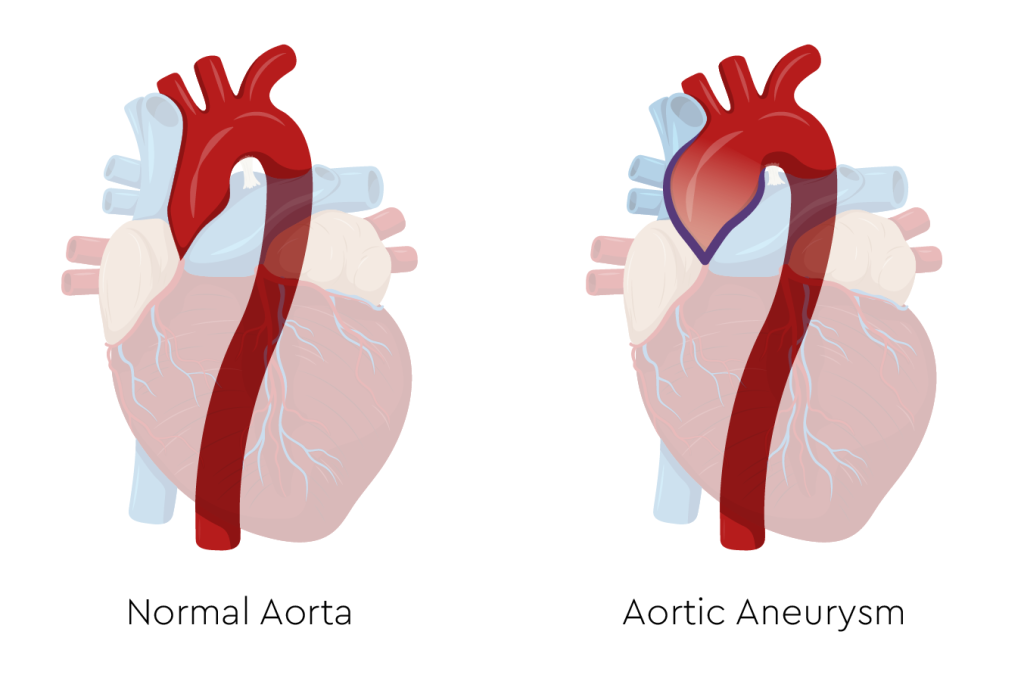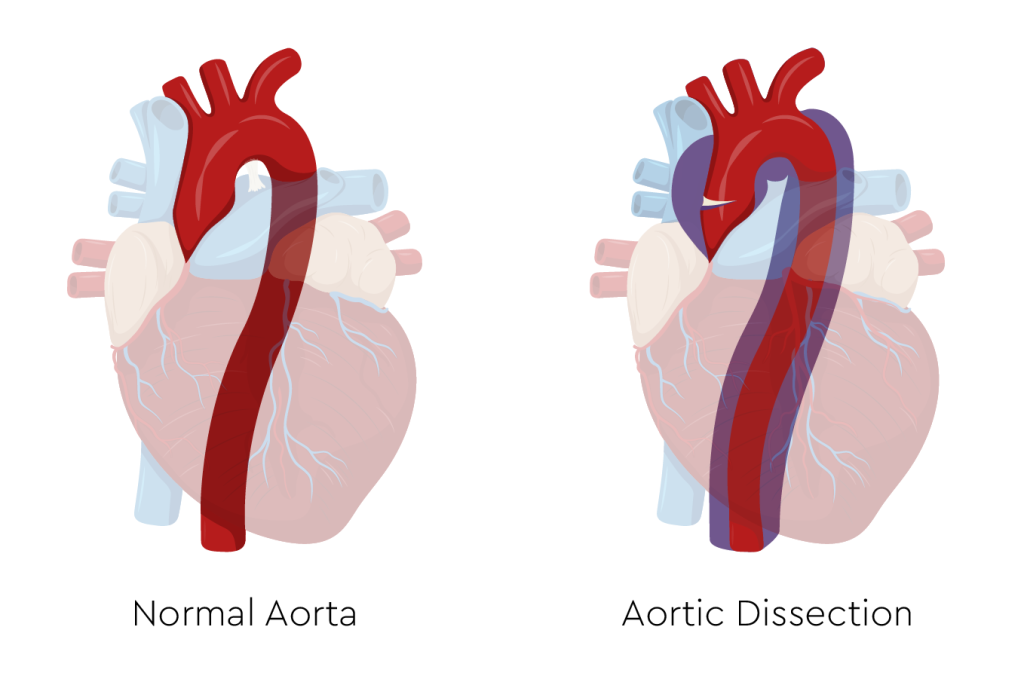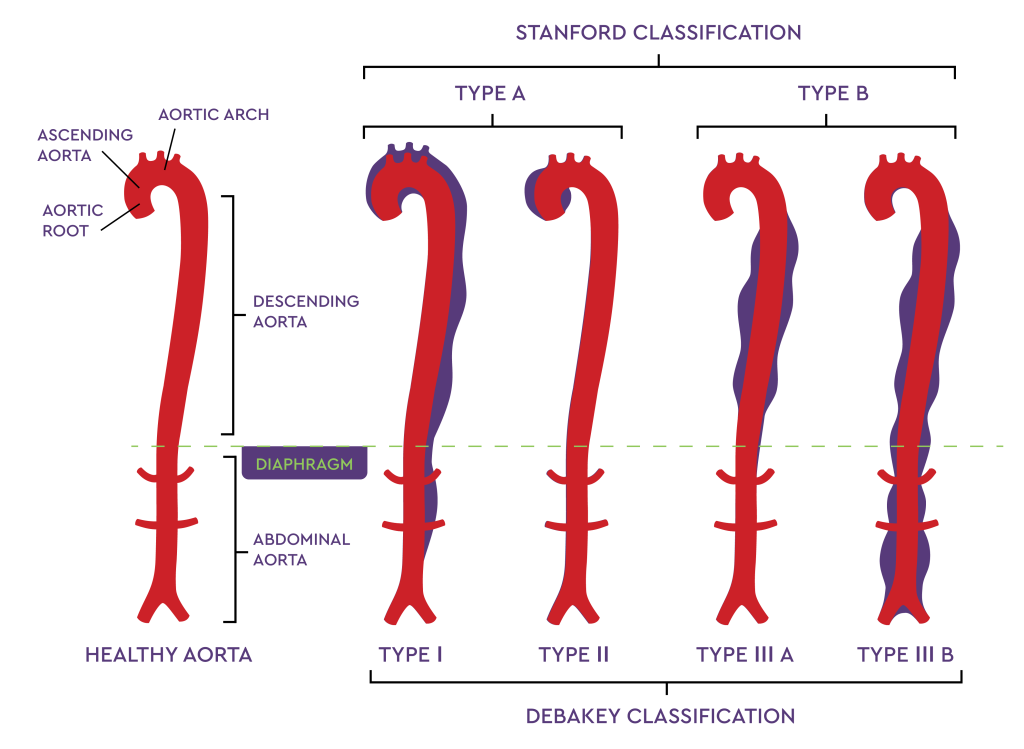What is Thoracic Aortic Disease?

An aortic aneurysm is a balloon-like bulge in the aorta that can occur in the first part of the aorta and involve the root of the aorta or the ascending aorta, or both.
Aneurysms are a serious problem because they can tear or rupture if not properly diagnosed and clinical managed.
Most often aneurysms do not cause any symptoms. Imaging is the only way to identify an aneurysm.

As an aneurysm enlarges, it increases the risk for an acute aortic dissection.
The aorta is made up of three layers. An aortic dissection happens when the blood tears through the inner layer of the aorta, and then starts to flow in the thick middle layer of the aorta, leading to blood flowing through the true lumen and a false lumen formed by the blood entering the wall.
An aortic dissection is a medical emergency and can cause sudden death, but these deaths are preventable with early diagnosis and management.
What are the types of dissections?
Acute aortic dissections are classified by where the tear begins in the aorta and how far the dissection goes. The Stanford system classifies dissections as type A or type B. The DeBakey system classifies dissections as type I, type II, or type III.

Risk factors for developing thoracic aortic aneurysms and aortic dissections
Several factors can increase your risk to develop a thoracic aortic aneurysm or aortic dissection.
- Family history of thoracic aortic aneurysm or thoracic aortic dissection
- A genetic condition that increases risk of aortic disease
- Uncontrolled hypertension (high blood pressure)
- Stimulant or illicit drug use (methamphetamine or cocaine)
- Bicuspid aortic valve
- High intensity weightlifting (see IRAD for recommendations regarding lifestyle and work)
- Trauma to the aorta (e.g. being in a car accident)
Depending on your specific condition other risk factors may apply.
The information provided here is not intended to be a substitute for professional medical advice, diagnosis, or treatment. Always seek the advice of your medical team or a qualified health provider.
- Tell your clinicians about anxiety or depression and get treatment. If untreated, these conditions may raise your blood pressure.
- Avoid tobacco and tobacco products.
- Take your antihypertensive medications every day. We recommend beta blockers (metoprolol, bisoprolol, atenolol, carvedilol) as the first choice and angiotensin receptor blockers (losartan, Irbesartan, valsartan, telmisartan) if needed. Sudden discontinuation of your medications may cause a hypertensive crisis that greatly increases your risk for an acute dissection.
- Do not take stimulants such as ephedra, cocaine, amphetamines and prescription medications that are not safe for people with high blood pressure, as these may trigger acute dissections. If you are unsure about whether a medication or dietary supplement is safe for you, please consult with your clinician.
- Fluoroquinolone antibiotics such as ciprofloxacin and levofloxacin that are used to treat urinary and respiratory infections may increase your risk to have an aortic dissection. If you are prescribed one of these antibiotics, please ask your clinician for alternatives.
- Get regular imaging tests of your heart and blood vessels. The frequency of these tests depends on the type of aortic disease you have. If you are not sure if you need these tests, talk to your cardiologist.
- Talk with your family members about your diagnosis and make your clinicians aware of your family history, because thoracic aortic aneurysm and dissections can “run in families” even when no genetic syndrome like Marfan syndrome is present in affected family members.
- Please recognize that vascular diseases of all kinds are lifelong conditions that put you at risk for future complications, even if you have had previous interventions. Make plans for what to do in the event of emergencies and share them with those who live with or care with you.
These are general guidelines intended for educational purposes only and will not be appropriate for every person with aortic disease. The information provided here is not intended to be a substitute for professional medical advice, diagnosis, or treatment. Always seek the advice of your medical team or a qualified health provider.
- Exercise is part of a healthy lifestyle because it can lower your blood pressure and should be included in the treatment plan for all patients with aortic disease.
- Before starting exercise, make sure that your blood pressure is well controlled.
- Take a beta blocker (such as metoprolol or atenolol) every day. This will reduce your risk to develop high blood pressure with exercise.
- Moderate aerobic activities (walking, jogging, running, yoga, pilates) are safe.
- Stay below your maximum target heart rate: (220 – your age) X 80%. This defines the upper limit of moderate exercise.
- Lifting light weights is OK, as long as you stop well before you can’t do another rep.
- When lifting, do not strain your chest or abdomen (Valsalva maneuver). The amount that individuals can lift safely will vary. The most weight that you can lift without straining your chest or abdomen is a reasonable weight limit for you.
- Isometric exercises (planking, wall sits), where you contract your muscles but do not move your joints, may not be safe for you if you have recently had aortic surgery or an acute aortic dissection. Your clinician can provide a letter explaining these restrictions if needed.
- If you are contemplating more intensive aerobic exercise, please consult with a clinician. We may recommend a treadmill stress test to determine whether it is safe for you before you are cleared for vigorous physical activity.
- Sexual activities are safe.
- Avoid contact sports.
No matter where you are on your aortic disease journey, we have developed resources to help you. Explore multiple topics on behalf of yourself or others to get the information you need to help us in our mission to prevent unnecessary suffering due to aortic disease. Keep in mind that these resources were developed for the broad aortic disease community and may not always cover all needs of each individual.
Always consult an aortic disease care provider when making medical decisions for yourself and family members.
Diagnosed With Aortic Disease?
Information and resources for those diagnosed with thoracic aortic aneurysms and dissections.
Diagnosed With Genetic Aortic Disease?
Information and resources for those at risk for aortic disease due to a genetic condition or risk.
Lost A Loved one?
Information and resources for those who have lost a loved one or family member to thoracic aortic dissection.
Family History Of Aortic Disease
If a family member has been diagnosed with aortic disease, you could be at risk. Find the resources and information you need to monitor your aortic health.
Family History Of A Genetic Aortic Condition
If a family member has tested positive for one of the known genetic markers associated with thoracic aortic disease, you and your other relatives could inherit that variant.

